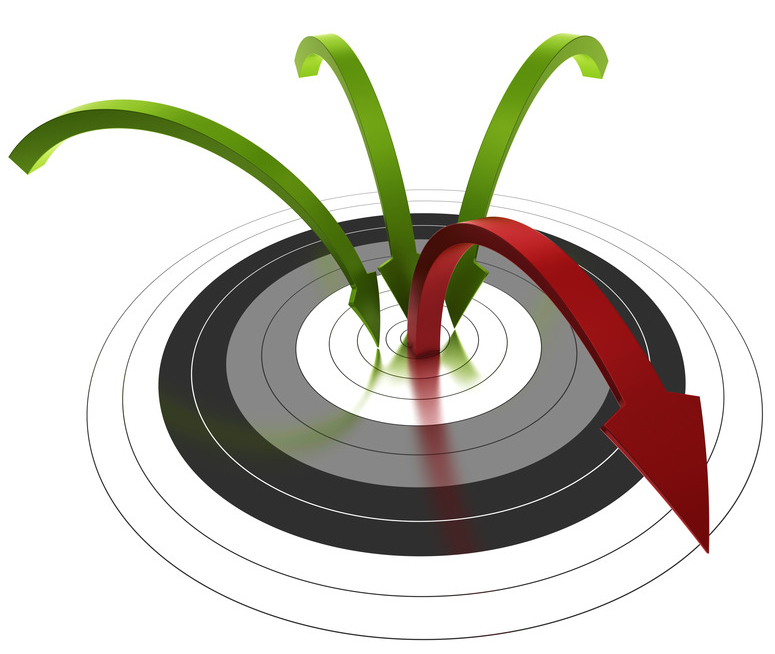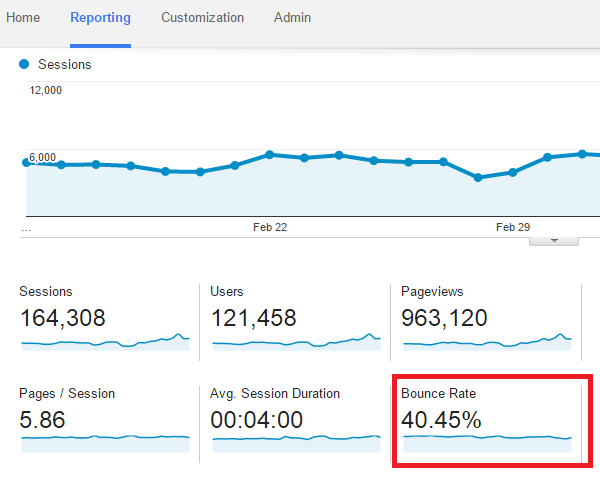How To Reduce Your Bounce Rate In Google Analytics
by Leanne Mordue on 24-Jan-2016 12:52:00

Bounce rate is something of a misunderstood metric, a dirty word in a world that demands you convert visitors into customers. Put simply, bounce rate is the percentage of visitors to your website who navigate away after viewing a single page. Google Analytics does the hard work, calculating your bounce rate for you – and this has nothing to do with the time visitors spend on your site.
Bounce rate can be a great way to measure the quality of traffic your landing page or website is getting, and you should take a high bounce rate seriously; it's usually indicative that site entrance pages such as your landing page or homepage are not relevant to your visitors, impacting your conversion rate. It's said that a bounce rate of over 35% should be cause for concern – anything higher than 50% and you should be worried. But what about reducing your bounce rate? We've got some tips on how to reduce bounce rates that will ensure your website performs better for your business.
Make your website more attractive
We've all seen them, those dull, featureless websites that don't stand out from the crowd. Maybe you're even guilty of creating one for your business (we hope not!) - but it doesn't have to be that way. A visually unappealing site can be off-putting to the user. When visitors arrive at your site, do they find it graphically eye-catching and easy-to-navigate? Pixilated images, dated graphics, annoying pop-ups and a disorganised layout can all detract from the end user experience, hitting your conversion rates hard. Creating friction like this stands in the way of conversion – not to mention it won't lead to happy customers either. Spend time on the design and layout of your website – it's more important than you might think.
Ensure your site is easy to navigate
Broken links, technical errors, slow load times, confusing navigation – these can all stand in the way of conversions, drastically increasing bounce rate. After all, we've all been in a situation where we've clicked off a site after waiting for content to load, or shouted in frustration as we get another '404 - page not found' screen when shopping online. This is where testing comes in. It's a good idea to ask colleagues or business contacts – even friends and family, to try completing tasks on your website and document any problems they encounter; even better if they have little to no knowledge or experience of your business and industry. Make sure that videos work – across all devices – and that it's easy for users to find what they are looking for.
Make sure your site meets user expectations
Ask yourself these two questions:
- What ad or website did visitors come from?
- What search terms did visitors use to get here?
Answering these questions will allow you to make assumptions as to what your website visitors are looking for – and that's important. Many users will arrive on your site after using a search engine – which is why it's so important to know exactly what they are searching for (their intent). This way you can ensure that your site matches their expectations. At the end of the day, if they're not looking to buy your products or use your services, it doesn't matter how good your homepage or landing pages are – you're going to experience high bounce rate.
Add a call to action
If your pages don't have a call-to-action, this can greatly affect bounce rate. Users need to be guided towards your goal and they shouldn't need to search or think too hard when they first land on your site. Your call-to-action should be in a prominent place on your landing page. It's also beneficial to include a 'search' function in a clear place on your homepage, in case users get lost. Matching the keywords you use in your adverts to your call-to-action wording makes it easier for users to spot what they're used to seeing. Read this article for more on call-to-actions: Four Tips For Developing Effective Call To Action Buttons
Reduce the number of calls-to-action
You can have too much of a good thing, and you don't want to distract users – they can hit the back button at any time. The best way to guide a user to your call-to-action is to ensure that there isn't really any other choice. Lay out a clear path for them so that they are guided to your goal; whether that's signing up to a mailing list or getting in touch for a quote – and you're sure to see a reduction in bounce rate.
These tips will help you to reduce your bounce rate, but keeping an eye on the number of users that 'bounce' should be an ongoing task. Remember, reducing your bounce rate will boost your conversions!
- Inbound Marketing (SEO, PPC, Social Media, Video) (824)
- Strategy (363)
- Sales & CRM (195)
- Marketing Automation & Email Marketing (190)
- Business Growth (164)
- Website Design (160)
- Hubspot (138)
- Lead Generation (115)
- Google Adwords (98)
- Content Marketing (94)
- Conversion (48)
- Case Studies (47)
- News (47)
- Ecommerce (39)
- Webinars (34)
- SEO (24)
- AI (20)
- Events (19)
- Video (17)
- LinkedIn Advertising (15)
- Video Selling (15)
- Software training (13)
- Niche business marketing (11)
- The Digital Prosperity Podcast (10)
- Facebook Advertising (6)
- HubSpot Case Studies (5)
- December 2025 (10)
- November 2025 (6)
- October 2025 (17)
- September 2025 (16)
- August 2025 (14)
- July 2025 (14)
- June 2025 (5)
- May 2025 (19)
- April 2025 (15)
- March 2025 (13)
- February 2025 (13)
- January 2025 (8)
- December 2024 (2)
- November 2024 (4)
- October 2024 (21)
- September 2024 (4)
- August 2024 (8)
- July 2024 (14)
- June 2024 (16)
- May 2024 (25)
- April 2024 (15)
- March 2024 (18)
- February 2024 (5)
- January 2024 (10)
- December 2023 (6)
- November 2023 (10)
- October 2023 (13)
- September 2023 (12)
- August 2023 (14)
- July 2023 (13)
- June 2023 (14)
- May 2023 (15)
- April 2023 (13)
- March 2023 (14)
- February 2023 (13)
- January 2023 (15)
- December 2022 (13)
- November 2022 (6)
- October 2022 (8)
- September 2022 (22)
- August 2022 (15)
- July 2022 (13)
- June 2022 (16)
- May 2022 (14)
- April 2022 (16)
- March 2022 (17)
- February 2022 (11)
- January 2022 (8)
- December 2021 (6)
- November 2021 (7)
- October 2021 (11)
- September 2021 (10)
- August 2021 (7)
- July 2021 (7)
- June 2021 (4)
- May 2021 (4)
- April 2021 (1)
- March 2021 (3)
- February 2021 (5)
- January 2021 (4)
- December 2020 (7)
- November 2020 (6)
- October 2020 (5)
- September 2020 (9)
- August 2020 (18)
- July 2020 (17)
- June 2020 (17)
- May 2020 (10)
- April 2020 (21)
- March 2020 (24)
- February 2020 (21)
- January 2020 (12)
- December 2019 (23)
- November 2019 (12)
- October 2019 (14)
- September 2019 (16)
- August 2019 (15)
- July 2019 (13)
- June 2019 (6)
- May 2019 (8)
- April 2019 (4)
- March 2019 (2)
- February 2019 (2)
- January 2019 (2)
- December 2018 (3)
- November 2018 (24)
- September 2018 (11)
- August 2018 (9)
- June 2018 (3)
- May 2018 (6)
- April 2018 (14)
- March 2018 (12)
- February 2018 (16)
- January 2018 (15)
- December 2017 (15)
- November 2017 (18)
- October 2017 (23)
- September 2017 (19)
- August 2017 (28)
- July 2017 (27)
- June 2017 (25)
- May 2017 (18)
- April 2017 (17)
- March 2017 (16)
- February 2017 (17)
- January 2017 (14)
- December 2016 (21)
- November 2016 (27)
- October 2016 (25)
- September 2016 (16)
- August 2016 (20)
- July 2016 (19)
- June 2016 (14)
- May 2016 (20)
- April 2016 (24)
- March 2016 (22)
- February 2016 (28)
- January 2016 (27)
- December 2015 (28)
- November 2015 (19)
- October 2015 (9)
- September 2015 (12)
- August 2015 (5)
- July 2015 (1)
- June 2015 (10)
- May 2015 (3)
- April 2015 (11)
- March 2015 (14)
- February 2015 (15)
- January 2015 (12)
- December 2014 (2)
- November 2014 (23)
- October 2014 (2)
- September 2014 (2)
- August 2014 (2)
- July 2014 (2)
- June 2014 (7)
- May 2014 (14)
- April 2014 (14)
- March 2014 (7)
- February 2014 (2)
- January 2014 (7)
- December 2013 (9)
- November 2013 (14)
- October 2013 (17)
- September 2013 (3)
- August 2013 (6)
- July 2013 (8)
- June 2013 (4)
- May 2013 (3)
- April 2013 (6)
- March 2013 (6)
- February 2013 (7)
- January 2013 (5)
- December 2012 (3)
- November 2012 (2)
- September 2012 (1)
Subscribe by email
You May Also Like
These Related Blogs

‘Bounce Rate’ in Google Analytics Explained - Why It Matters & How to Improve It
Is your website performing optimally? Are your site visitors staying on your site to explore it, or are they leaving after reviewing only the landing …

What Is Google Analytics Bounce Rate & How To Reduce It
Your Bounce Rate is a good indication of how successful or unsuccessful your webpages are at capturing a visitor’s interest. By analysing the bounce r …
.jpg)
Why Blog Articles Often Have High Bounce Rates (And What To Do About It)
Producing regular articles for the blog on your website is a way of significantly growing your website traffic, building an audience, establishing you …



